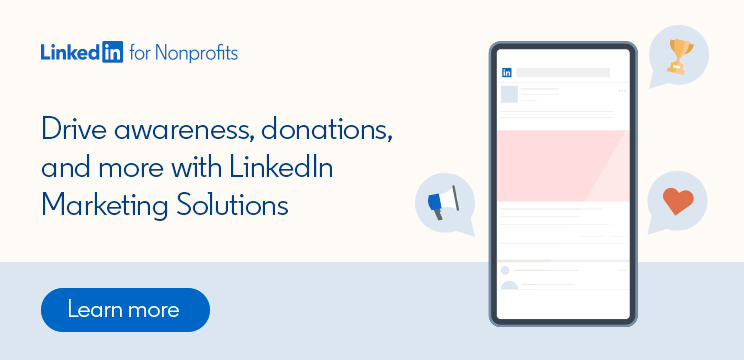
4 Nonprofit Marketing Ideas You May Not Have Tried Before
Generating nonprofit marketing ideas can be tough. It’s not always obvious which value proposition is going to connect with your audience the most. You may worry that returning to the same messaging time and again will dilute its effectiveness.
If you’re struggling to market your nonprofit, don’t be afraid to think outside of the box! These four oft-overlooked nonprofit marketing ideas each have the potential to help you deepen the engagement of your current supporters, while also putting your cause in front of valuable new audiences.
1. Host a LinkedIn Live event
LinkedIn Live videos receive six times more reactions and 23x more comments than native videos on average, which can make them an effective way to capture your audience’s attention in real time.
LinkedIn Live events can be especially useful for sharing exciting announcements, such as big organizational updates or donation drives. Live-streaming from an event you’re hosting or attending, such as a gala or conference, is also a great way to reach a wider audience than might otherwise be able to attend.
For best results, avoid going live too often, as this may make your audience less responsive to notifications about your live videos in the future. It’s also worth tapping a team member to act as a live chat moderator, responding to audience questions and comments in the moment to encourage deeper engagement.
Even after your event ends, it can still be a valuable marketing asset. LinkedIn Live videos are automatically recorded and can be played back from your nonprofit’s LinkedIn Page at any time. That means you can include the link in newsletters, blog posts, and other marketing assets.
2. Try peer-to-peer marketing
Peer-to-peer fundraising can help you reach your audience in a direct, personally relevant way. Potential donors may be more likely to accept and respond to a message from a peer than a stranger or an organization’s account. The same logic can be used for marketing.
When you produce a great piece of content, encourage staff, leaders, and volunteers to share it on LinkedIn or other platforms, or even send it directly to people in their networks who may be interested. If their connections respond, you or your team can then suggest they follow your LinkedIn Page, join your mailing list, or take another action to learn more about your organization.

Avoid overburdening your team or jeopardizing their relationships with peers by asking them to share marketing content too frequently. Peer-to-peer marketing should always feel like a “win-win.” When in doubt, ask yourself if the content is impactful enough that the recipient would truly appreciate the share.
3. Let your audience choose their own path with Conversation Ads
Conversation Ads are a type of LinkedIn Ad that allow ad recipients to choose the information they need or the action they want to take.
Conversation Ads appear in your target recipient’s LinkedIn inbox, sharing a message along with a pre-set series of “response” CTAs. Each of these CTA responses leads the recipient down a different path that you have created. For example, if you were marketing a donation drive, the first CTA might take the recipient directly to the donation page, while the second could offer more information about what the impact their donation will make. By clicking the second CTA, they’ll generate an additional message that you have created sharing more information.
One major advantage of sending Conversation Ads is you can send them as an individual member, rather than as your organization. This makes your ad look more like a message from a real person, which LinkedIn data shows can lead to a 16% increase in open rate, 10% increase in click-through rate (CTR), and 10% increase in conversion rate compared to ads sent from a company.
Conversation ads can also be a useful way to learn more about your target audience. Using Campaign Manager’s reporting analytics, you can view detailed click reporting on your Conversation Ad campaigns. Not only will you be able to see who clicked into your Conversation Ads, but you’ll also be able to see which CTA options they clicked on. This can help you evaluate the language and options your audience is interested in, empowering you to optimize your Conversation Ads and other marketing messaging over time.
4. Encourage your leaders to embrace thought leadership
Your leadership team likely has a wealth of knowledge about your nonprofit’s cause, along with a unique and valuable perspective on why your mission matters and how advocates can help move it forward. This perspective can become one of your nonprofit’s most valuable marketing tools.
Encourage your leaders to start posting thought leadership content from their own LinkedIn profiles on a regular basis. This could include authoring articles, posting recaps from events they attend, or sharing their point of view on news stories relevant to your organization’s work. Content that comes directly from your leaders may engage members of their network and help you reach valuable audiences that might not interact with other content from your organization — yet.
Where possible, offer your leaders help and support in creating this content and responding to key comments to make it an easier lift for them. The more active your leadership team can be on LinkedIn, the more valuable the network they’ve built becomes to your nonprofit.
Find more nonprofit marketing ideas by visiting the LinkedIn for Nonprofits Resource Hub.

